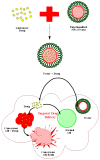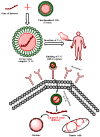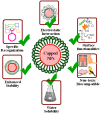Significance of Capping Agents of Colloidal Nanoparticles from the Perspective of Drug and Gene Delivery, Bioimaging, and Biosensing: An Insight
- PMID: 36142435
- PMCID: PMC9505579
- DOI: 10.3390/ijms231810521
Significance of Capping Agents of Colloidal Nanoparticles from the Perspective of Drug and Gene Delivery, Bioimaging, and Biosensing: An Insight
Abstract
The over-growth and coagulation of nanoparticles is prevented using capping agents by the production of stearic effect that plays a pivotal role in stabilizing the interface. This strategy of coating the nanoparticles' surface with capping agents is an emerging trend in assembling multipurpose nanoparticles that is beneficial for improving their physicochemical and biological behavior. The enhancement of reactivity and negligible toxicity is the outcome. In this review article, an attempt has been made to introduce the significance of different capping agents in the preparation of nanoparticles. Most importantly, we have highlighted the recent progress, existing roadblocks, and upcoming opportunities of using surface modified nanoparticles in nanomedicine from the drug and gene delivery, bioimaging, and biosensing perspectives.
Keywords: biosensing; capping agents; diagnostics; drug delivery; nanoparticles; therapeutics.
Conflict of interest statement
The authors declare no conflict of interest.
Figures






Similar articles
-
Role of capping agents in the application of nanoparticles in biomedicine and environmental remediation: recent trends and future prospects.J Nanobiotechnology. 2020 Nov 23;18(1):172. doi: 10.1186/s12951-020-00704-4. J Nanobiotechnology. 2020. PMID: 33225973 Free PMC article. Review.
-
Nanomedicine for drug delivery and imaging: a promising avenue for cancer therapy and diagnosis using targeted functional nanoparticles.Int J Cancer. 2007 Jun 15;120(12):2527-37. doi: 10.1002/ijc.22709. Int J Cancer. 2007. PMID: 17390371 Review.
-
Anisotropic noble metal nanoparticles: Synthesis, surface functionalization and applications in biosensing, bioimaging, drug delivery and theranostics.Acta Biomater. 2017 Feb;49:45-65. doi: 10.1016/j.actbio.2016.11.066. Epub 2016 Nov 30. Acta Biomater. 2017. PMID: 27915023 Review.
-
An Overview of Green Synthesis and Potential Pharmaceutical Applications of Nanoparticles as Targeted Drug Delivery System in Biomedicines.Drug Res (Stuttg). 2022 Jun;72(5):274-283. doi: 10.1055/a-1801-6793. Epub 2022 May 13. Drug Res (Stuttg). 2022. PMID: 35562101 Review.
-
Advancement of nanoscience in development of conjugated drugs for enhanced disease prevention.Life Sci. 2021 Mar 1;268:118859. doi: 10.1016/j.lfs.2020.118859. Epub 2021 Jan 30. Life Sci. 2021. PMID: 33358907 Review.
Cited by
-
Functional Nanomaterials for Advanced Bioelectrode Interfaces: Recent Advances in Disease Detection and Metabolic Monitoring.Sensors (Basel). 2025 Jul 15;25(14):4412. doi: 10.3390/s25144412. Sensors (Basel). 2025. PMID: 40732539 Free PMC article. Review.
-
Phytonanoparticles as novel drug carriers for enhanced osteogenesis and osseointegration.Discov Nano. 2025 Jan 16;20(1):11. doi: 10.1186/s11671-024-04164-9. Discov Nano. 2025. PMID: 39821381 Free PMC article. Review.
-
Protein-Based Silver Nanoparticles: Synthesis, Characterization, Administration, and Nanomedicine Applications.Int J Biomater. 2025 May 26;2025:5533798. doi: 10.1155/ijbm/5533798. eCollection 2025. Int J Biomater. 2025. PMID: 40458607 Free PMC article. Review.
-
Synthesis, biomedical applications, and toxicity of CuO nanoparticles.Appl Microbiol Biotechnol. 2023 Feb;107(4):1039-1061. doi: 10.1007/s00253-023-12364-z. Epub 2023 Jan 13. Appl Microbiol Biotechnol. 2023. PMID: 36635395 Free PMC article. Review.
-
Green Synthesis of Gold Nanoparticles Using Liquiritin and Other Phenolics from Glycyrrhiza glabra and Their Anti-Inflammatory Activity.J Funct Biomater. 2024 Apr 6;15(4):95. doi: 10.3390/jfb15040095. J Funct Biomater. 2024. PMID: 38667552 Free PMC article.
References
-
- Javed R., Ahmad M.A., Ao Q. Theranostic Applications of Nanobiotechnology in Cancer. In: Rai M., Jamil B., editors. Nanotheranostics. Springer; Cham, Swizherland: 2019. - DOI
-
- Gulati S., Sachdeva M., Bhasin K.K. Capping agents in nanoparticle synthesis: Surfactant and solvent system. AIP Conf. Proc. 2018;1953:030214. doi: 10.1063/1.5032549. - DOI
Publication types
MeSH terms
Substances
Grants and funding
LinkOut - more resources
Full Text Sources
Other Literature Sources

